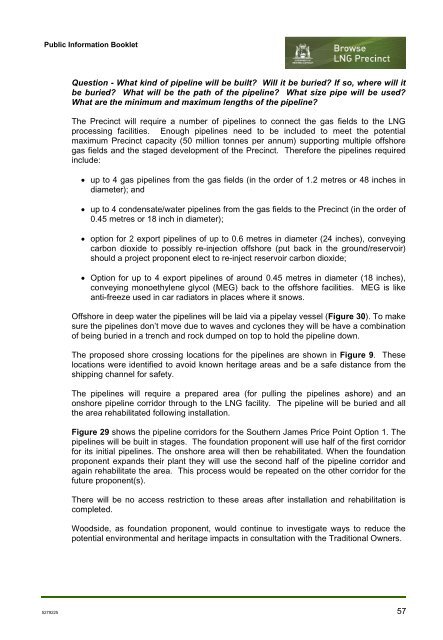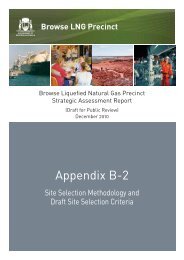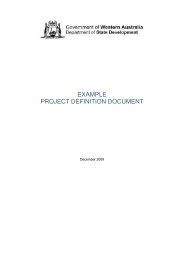Browse LNG Precinct - Public Information Booklet - Department of ...
Browse LNG Precinct - Public Information Booklet - Department of ...
Browse LNG Precinct - Public Information Booklet - Department of ...
Create successful ePaper yourself
Turn your PDF publications into a flip-book with our unique Google optimized e-Paper software.
<strong>Public</strong> <strong>Information</strong> <strong>Booklet</strong><br />
Question - What kind <strong>of</strong> pipeline will be built? Will it be buried? If so, where will it<br />
be buried? What will be the path <strong>of</strong> the pipeline? What size pipe will be used?<br />
What are the minimum and maximum lengths <strong>of</strong> the pipeline?<br />
The <strong>Precinct</strong> will require a number <strong>of</strong> pipelines to connect the gas fields to the <strong>LNG</strong><br />
processing facilities. Enough pipelines need to be included to meet the potential<br />
maximum <strong>Precinct</strong> capacity (50 million tonnes per annum) supporting multiple <strong>of</strong>fshore<br />
gas fields and the staged development <strong>of</strong> the <strong>Precinct</strong>. Therefore the pipelines required<br />
include:<br />
� up to 4 gas pipelines from the gas fields (in the order <strong>of</strong> 1.2 metres or 48 inches in<br />
diameter); and<br />
� up to 4 condensate/water pipelines from the gas fields to the <strong>Precinct</strong> (in the order <strong>of</strong><br />
0.45 metres or 18 inch in diameter);<br />
� option for 2 export pipelines <strong>of</strong> up to 0.6 metres in diameter (24 inches), conveying<br />
carbon dioxide to possibly re-injection <strong>of</strong>fshore (put back in the ground/reservoir)<br />
should a project proponent elect to re-inject reservoir carbon dioxide;<br />
� Option for up to 4 export pipelines <strong>of</strong> around 0.45 metres in diameter (18 inches),<br />
conveying monoethylene glycol (MEG) back to the <strong>of</strong>fshore facilities. MEG is like<br />
anti-freeze used in car radiators in places where it snows.<br />
Offshore in deep water the pipelines will be laid via a pipelay vessel (Figure 30). To make<br />
sure the pipelines donít move due to waves and cyclones they will be have a combination<br />
<strong>of</strong> being buried in a trench and rock dumped on top to hold the pipeline down.<br />
The proposed shore crossing locations for the pipelines are shown in Figure 9. These<br />
locations were identified to avoid known heritage areas and be a safe distance from the<br />
shipping channel for safety.<br />
The pipelines will require a prepared area (for pulling the pipelines ashore) and an<br />
onshore pipeline corridor through to the <strong>LNG</strong> facility. The pipeline will be buried and all<br />
the area rehabilitated following installation.<br />
Figure 29 shows the pipeline corridors for the Southern James Price Point Option 1. The<br />
pipelines will be built in stages. The foundation proponent will use half <strong>of</strong> the first corridor<br />
for its initial pipelines. The onshore area will then be rehabilitated. When the foundation<br />
proponent expands their plant they will use the second half <strong>of</strong> the pipeline corridor and<br />
again rehabilitate the area. This process would be repeated on the other corridor for the<br />
future proponent(s).<br />
There will be no access restriction to these areas after installation and rehabilitation is<br />
completed.<br />
Woodside, as foundation proponent, would continue to investigate ways to reduce the<br />
potential environmental and heritage impacts in consultation with the Traditional Owners.<br />
5279225 57









